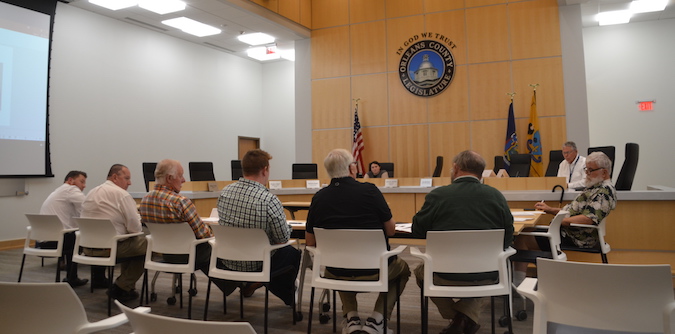County legislator presses need for more housing options in Orleans

Photos by Tom Rivers: Orleans County Legislator Ken DeRoller spoke at last month’s Orleans County Planning Board, sharing his concerns about current zoning that pushes for larger lot sizes, making it more costly to build new houses.
ALBION – An Orleans County legislator who will be retiring on Dec. 31 is making a strong push before he leaves office to have local municipalities start working to make changes to reverse a population decline.
Ken DeRoller of Kendall said the municipalities need to review their zoning and ordinances and allow smaller lot sizes for smaller new houses, which would make the projects more affordable. He also said many younger adults and senior citizens would prefer high-density housing such as townhouses and condominiums.
“I’m concerned about what I see here in Orleans County in regards to housing,” DeRoller told the Orleans County Planning Board on Sept. 23. “I charge this planning group to have conversations to make sure we have the right zoning and policies for the right housing mix.”
He sees plummeting student enrollments in school districts in the past generation despite school districts with very high graduation rates. The enrollment for the five districts is down 20.7 percent in a decade from 2008-09 to 2018-19. The districts went from 7,155 students in 2008-09 to 5,673 in 2018-19.
Housing is part of the equation for attracting and keeping people in the county, DeRoller said. The county also needs more higher-paying jobs, he said.
There are currently 15,200 people working in the county, and half of those positions are filled by people who don’t live in Orleans, DeRoller said.
He suspects many of the workers driving into the county would stay in Orleans with the right housing options.
The county legislator suggested the municipalities work with the ag community to identify some farmland that could be used for smaller building lots. Right now about half or 128,802 acres of the county’s total acreage receives an ag exemption. There are 117,380 acres in the county’s ag district.

The County Planning Board discussed a housing study during its meeting on Sept. 23.
Orleans has an aging population with the average age up from 36 in 2000 to 43 in 2019. As people become senior citizens they typically like to stay near friends and family, but DeRoller said many Orleans County seniors move to senior housing in Brockport, Batavia or Rochester because of limited sites in Orleans County.
“We need pressure on our municipal leadership to work on these issues,” DeRoller told the Planning Board.
He also has been a driving force on a committee working on a waterfront development plan for the Erie Canal. That document will soon go before municipal boards for their approval. DeRoller said the canal is underutilized. He is talking with developers about creating more housing options along the historic waterway.
He also is working on a waterfront development plan for Lake Ontario and Johnson Creek, with housing a part of that initiative.
“The Lake Ontario shoreline is an economic engine with tax value,” DeRoller said.
He is pleased to see a more fortified shoreline with stronger breakwalls, and said a $9 million sewer project in Kendall should result in more residents.
The four local villages also have spots for new housing and high-density projects. Albion, Medina and Holley, however, have some of the highest combined taxes – village, town, school and county – in the country, as a percentage of overall household income. Those villages need to be more affordable to be more appealing for retaining and attracting residents and businesses, DeRoller said.
Paul Hendel, a member of the Planning Board, also heads the Orleans County Economic Development Agency. He said housing is a critical piece to attracting businesses to the county.
“It’s a domino effect,” Hendel said. “Businesses if they relocate here want to know where will they live.”

Ken DeRoller also spoke with the Albion Rotary Club, going over the housing study with showed a population drop of 9 percent in the county over 20 years from 2000 to 2020. DeRoller would like to see more housing options – smaller lots for new builds, and townhouses and condominiums.
Gary Daum, a Planning Board member from Yates, said he sees many properties in distress that aren’t well maintained. He sees many abandoned houses throughout the county. He wondered if service groups could take up mowing lawns and trimming bushes.
“Show that you care – clean up and repair,” Daum said.
He also highlighted Yates town officials who are working on a $2.5 million upgrade of the Town Park along Lake Ontario. That project will be a significant boost to the local quality of life.
Some of the key findings in a housing study by LaBella for Orleans include:
- The county has an aging housing stock and about half of the houses need repairs.
- The median household income in the county also makes it difficult for landlords to charge enough rent, making for a low return on investment.
- Building permits for housing are about a third of what they were 15 years ago. The redevelopment of the former Holley High School, which added 42 apartment units last year, is an exception. Those units were quickly rented out and show there is demand for high-density living in the county.
- Single-family, owner-occupied units dominate the market: About 50 percent of housing stock throughout the county is comprised of single-family homes on large lots. Future projections show a need for smaller homes on smaller lot sizes, which would also drive down the costs for a new house.
- Almost 50 percent of renter households have housing problems and cannot afford market rents: The report states that 49 percent of renters are living in units that are not affordable. Housing Choice vouchers available in the county address some of the affordability issues, but only a small fraction of the need. The report also says 51 percent of renters have housing problems such as incomplete kitchens or bathrooms and more than one person per bedroom.
- More than 50 percent of housing stock is 60 years or older: Housing maintenance is therefore a major priority in the county, Labella stated in the report.
- Renters and homeowners both have housing problems: The number of homeowners with housing problems (3,010, according to the report) exceeds the number of renters (2,010) with housing problems.
- Return on investment is low for owners and rental developers: Rental rates in inflation adjusted dollars have decreased over the last 20 years, and home values, in inflation adjusted dollars, are also down in the 20 years. (This doesn’t include the recent spike in the past year with many homes selling for 20 to 25 percent above assessed value.) The lack of growth in rental rates and home values discourages upgrades and maintenance of homes, as well as new developments.
- Population decreasing: Orleans County’s population is down 5.9 percent from 2010 to 2020 or by 2,540 people, from 42,883 to 40,343. From 2000, the decline is 8.7 percent when the population was 44,171. “Finding ways to attract new residents would increase the demand for housing,” the report states.
- Shrinking household sizes: The size of the average household shrunk from 2.65 in 2000 to 2.28 in 2019.
- The report also finds a need for more housing units for extremely low-income households, and there is also demand for higher-priced apartments.
















































































